1. Hwang JH, Smith CA, Salhia B, et al. The role of fascin in the migration and invasiveness of malignant glioma cells. Neoplasia. 2008; 10:149–159. PMID:
18283337.

2. Park KS, Lee HW, Park SH, et al. The clinical significance of fascin expression in a newly diagnosed primary glioblastoma. J Neurooncol. 2016; 129:495–503. PMID:
27406586.

3. Roma AA, Prayson RA. Fascin expression in 90 patients with glioblastoma multiforme. Ann Diagn Pathol. 2005; 9:307–311. PMID:
16308158.

4. Al-Alwan M, Olabi S, Ghebeh H, et al. Fascin is a key regulator of breast cancer invasion that acts via the modification of metastasis associated molecules. PLoS One. 2011; 6:e27339. PMID:
22076152.
5. Yao J, Qian CJ, Ye B, et al. Signal transducer and activator of transcription 3 signaling upregulates fascin via nuclear factor-κB in gastric cancer: implications in cell invasion and migration. Oncol Lett. 2014; 7:902–908. PMID:
24527098.

6. Gunal A, Onguru O, Safali M, et al. Fascin expression [corrected] in glial tumors and its prognostic significance in glioblastomas. Neuropathology. 2008; 28:382–386. PMID:
18298442.
7. Joo JD, Kim H, Kim YH, et al. Validation of the effectiveness and safety of temozolomide during and after radiotherapy for newly diagnosed glioblastomas: 10-year experience of a single institution. J Korean Med Sci. 2015; 30:1597–1603. PMID:
26539003.

8. Peraud A, Mondal S, Hawkins C, et al. Expression of fascin, an actin-bundling protein, in astrocytomas of varying grades. Brain Tumor Pathol. 2003; 20:53–58. PMID:
14756441.

9. Sordillo LA, Sordillo PP, Helson L. Curcumin for the treatment of glioblastoma. Anticancer Res. 2015; 35:6373–6378. PMID:
26637846.
10. Aggarwal BB, Kumar A, Bharti AC. Anticancer potential of curcumin: preclinical and clinical studies. Anticancer Res. 2003; 23:363–398. PMID:
12680238.
11. López-Lázaro M. Anticancer and carcinogenic properties of curcumin: considerations for its clinical development as a cancer chemopreventive and chemotherapeutic agent. Mol Nutr Food Res. 2008; 52(Suppl 1):S103–S127. PMID:
18496811.

12. Hartojo W, Silvers AL, Thomas DG, et al. Curcumin promotes apoptosis, increases chemosensitivity, and inhibits nuclear factor kappaB in esophageal adenocarcinoma. Transl Oncol. 2010; 3:99–108. PMID:
20360934.
13. Belkaid A, Copland IB, Massillon D, et al. Silencing of the human microsomal glucose-6-phosphate translocase induces glioma cell death: potential new anticancer target for curcumin. FEBS Lett. 2006; 580:3746–3752. PMID:
16777101.

14. Nagai S, Kurimoto M, Washiyama K, et al. Inhibition of cellular proliferation and induction of apoptosis by curcumin in human malignant astrocytoma cell lines. J Neurooncol. 2005; 74:105–111. PMID:
16193380.

15. Patel BB, Gupta D, Elliott AA, et al. Curcumin targets FOLFOX-surviving colon cancer cells via inhibition of EGFRs and IGF-1R. Anticancer Res. 2010; 30:319–325. PMID:
20332435.
16. Senft C, Polacin M, Priester M, et al. The nontoxic natural compound Curcumin exerts anti-proliferative, anti-migratory, and anti-invasive properties against malignant gliomas. BMC Cancer. 2010; 10:491. PMID:
20840775.

17. Woo MS, Jung SH, Kim SY, et al. Curcumin suppresses phorbol ester-induced matrix metalloproteinase-9 expression by inhibiting the PKC to MAPK signaling pathways in human astroglioma cells. Biochem Biophys Res Commun. 2005; 335:1017–1025. PMID:
16102725.

18. Parsa AT. A newly identified transcriptional network for mesenchymal transformation of brain tumors: potential targets for therapeutic intervention. World Neurosurg. 2010; 73:424. PMID:
20920910.

19. Adams JC. Formation of stable microspikes containing actin and the 55 kDa actin bundling protein, fascin, is a consequence of cell adhesion to thrombospondin-1: implications for the anti-adhesive activities of thrombospondin-1. J Cell Sci. 1995; 108(Pt 5):1977–1990. PMID:
7657718.

20. Adams JC. Characterization of cell-matrix adhesion requirements for the formation of fascin microspikes. Mol Biol Cell. 1997; 8:2345–2363. PMID:
9362073.

21. Adams JC, Kureishy N, Taylor AL. A role for syndecan-1 in coupling fascin spike formation by thrombospondin-1. J Cell Biol. 2001; 152:1169–1182. PMID:
11257118.

22. Edwards RA, Bryan J. Fascins, a family of actin bundling proteins. Cell Motil Cytoskeleton. 1995; 32:1–9. PMID:
8674129.

23. Edwards RA, Herrera-Sosa H, Otto J, et al. Cloning and expression of a murine fascin homolog from mouse brain. J Biol Chem. 1995; 270:10764–10770. PMID:
7738015.

24. Kureishy N, Sapountzi V, Prag S, et al. Fascins, and their roles in cell structure and function. Bioessays. 2002; 24:350–361. PMID:
11948621.

25. Vignjevic D, Kojima S, Aratyn Y, et al. Role of fascin in filopodial protrusion. J Cell Biol. 2006; 174:863–875. PMID:
16966425.

26. Kunnumakkara AB, Anand P, Aggarwal BB. Curcumin inhibits proliferation, invasion, angiogenesis and metastasis of different cancers through interaction with multiple cell signaling proteins. Cancer Lett. 2008; 269:199–225. PMID:
18479807.

27. Dhandapani KM, Mahesh VB, Brann DW. Curcumin suppresses growth and chemoresistance of human glioblastoma cells via AP-1 and NFkappaB transcription factors. J Neurochem. 2007; 102:522–538. PMID:
17596214.
28. Kunnumakkara AB, Diagaradjane P, Anand P, et al. Curcumin sensitizes human colorectal cancer to capecitabine by modulation of cyclin D1, COX-2, MMP-9, VEGF and CXCR4 expression in an orthotopic mouse model. Int J Cancer. 2009; 125:2187–2197. PMID:
19623659.

29. Sandur SK, Deorukhkar A, Pandey MK, et al. Curcumin modulates the radiosensitivity of colorectal cancer cells by suppressing constitutive and inducible NF-kappaB activity. Int J Radiat Oncol Biol Phys. 2009; 75:534–542. PMID:
19735878.
30. Gao X, Deeb D, Jiang H, et al. Curcumin differentially sensitizes malignant glioma cells to TRAIL/Apo2L-mediated apoptosis through activation of procaspases and release of cytochrome c from mitochondria. J Exp Ther Oncol. 2005; 5:39–48. PMID:
16416600.
31. Karmakar S, Banik NL, Patel SJ, et al. Curcumin activated both receptor-mediated and mitochondria-mediated proteolytic pathways for apoptosis in human glioblastoma T98G cells. Neurosci Lett. 2006; 407:53–58. PMID:
16949208.

32. Kim SY, Jung SH, Kim HS. Curcumin is a potent broad spectrum inhibitor of matrix metalloproteinase gene expression in human astroglioma cells. Biochem Biophys Res Commun. 2005; 337:510–516. PMID:
16198311.

33. Liu C, Gao H, Cao L, et al. The role of FSCN1 in migration and invasion of pituitary adenomas. Mol Cell Endocrinol. 2016; 419:217–224. PMID:
26522130.

34. Senft C, Priester M, Polacin M, et al. Inhibition of the JAK-2/STAT3 signaling pathway impedes the migratory and invasive potential of human glioblastoma cells. J Neurooncol. 2011; 101:393–403. PMID:
20589525.

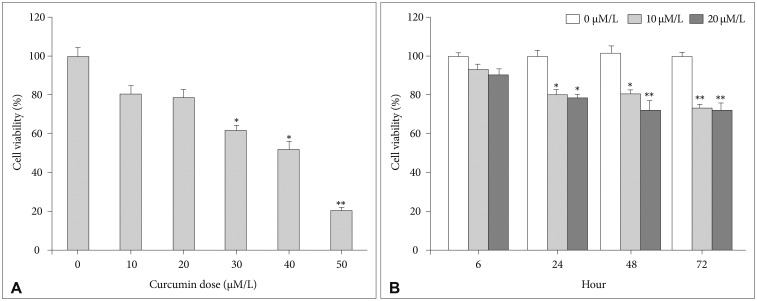
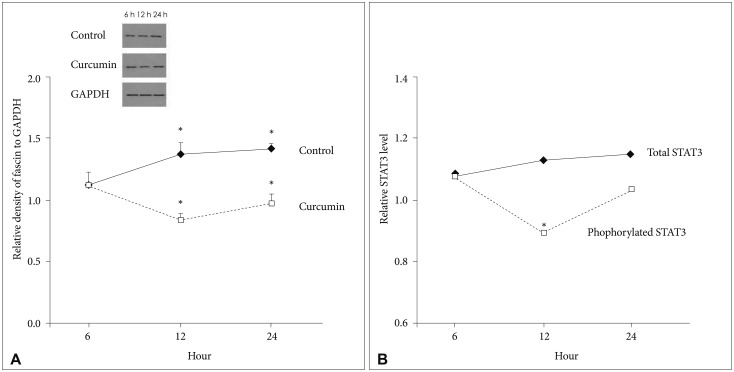
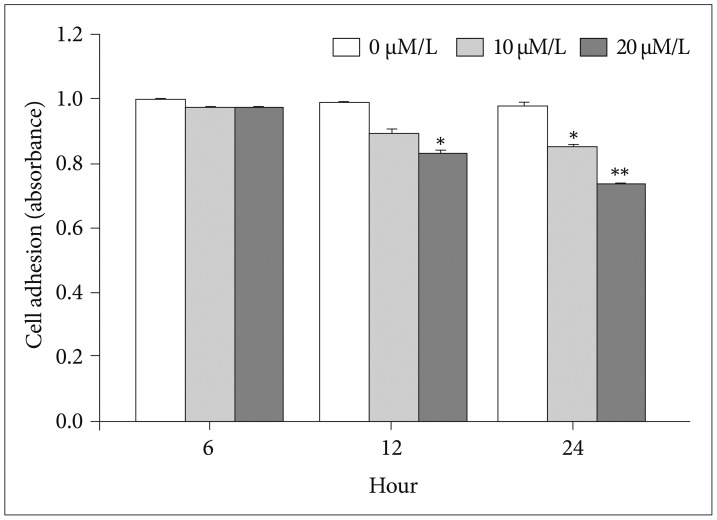
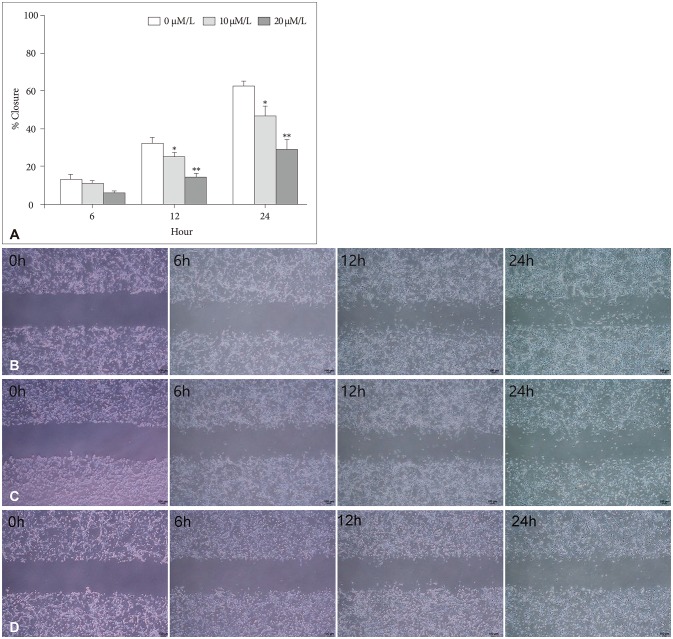
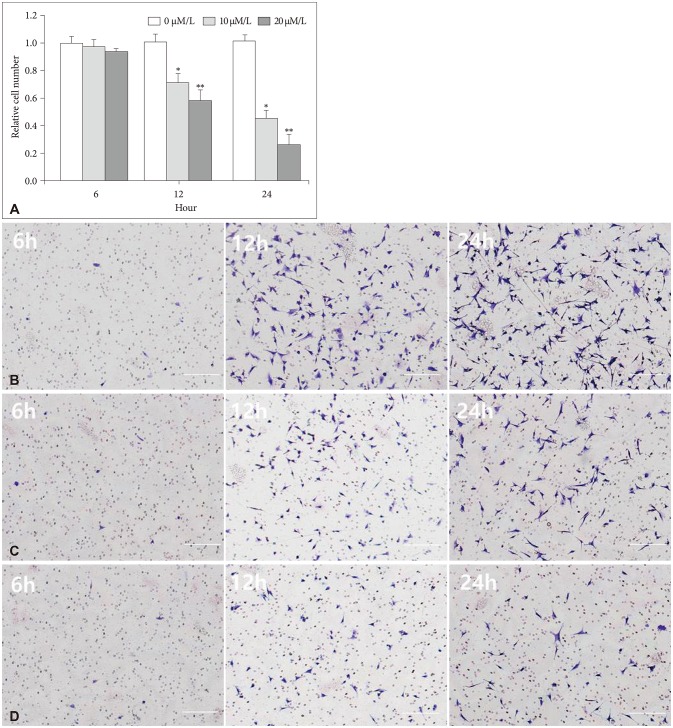
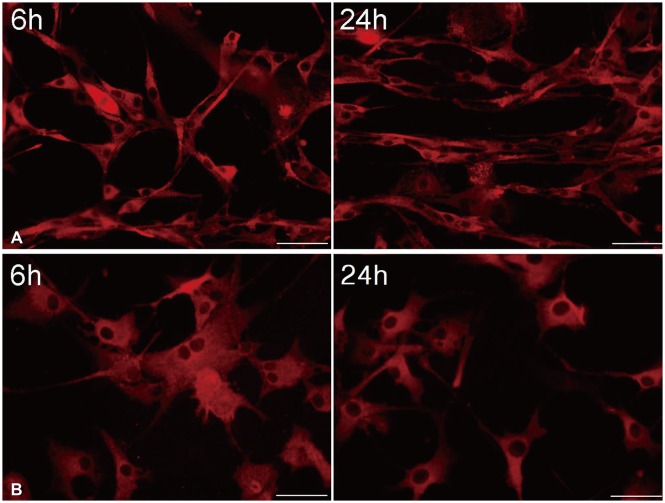




 PDF
PDF ePub
ePub Citation
Citation Print
Print


 XML Download
XML Download